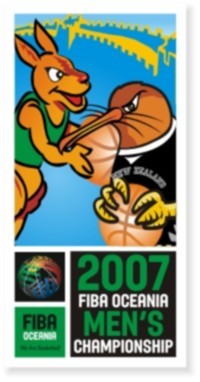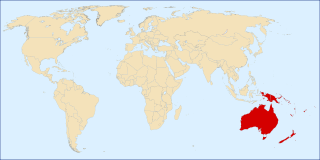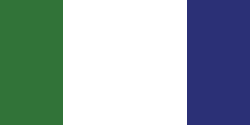Road traffic
| | This section is empty. You can help by adding to it. (July 2010) |
Transport in Oceania is most advanced in Australia, Hawaii and New Zealand, though all countries in the region have faced difficulties in providing facilities due to their low population density. Smaller islands are dependent on sea and air transport, but have had difficulties operating either national or regional airlines and shipping lines.
Rail transport is mainly restricted to Australia and New Zealand, with some rail lines in Fiji and Nauru (and formerly in New Caledonia and Papua New Guinea).
| | This section is empty. You can help by adding to it. (July 2010) |
| | This section is empty. You can help by adding to it. (July 2010) |
| | This section is empty. You can help by adding to it. (July 2010) |

Badminton Oceania (BO) is the governing body of badminton in Oceania. It is one of the 5 continental bodies under the flag of the Badminton World Federation (BWF). The confederation has 17 member countries. Papua New Guinea is the newest member, which was granted membership in late 2016.

The FIBA Oceania Championship for Men 2007 was the qualifying tournament of FIBA Oceania for the men's basketball tournament at the 2008 Summer Olympics at Beijing. The tournament, a best-of-three series between Australia and New Zealand, was held in Melbourne, Sydney and Brisbane. Australia won the first two games to qualify for the Olympics, while New Zealand won the third game and took part in the FIBA wildcard tournament.
The FIBA Oceania Championship for Men 1999 was the qualifying tournament of FIBA Oceania for the 2000 Summer Olympics. Australia did not enter this tournament because they took the host spot of the Olympic tournament. The tournament was a one-game playoff between Guam and New Zealand, held in Auckland. New Zealand won and qualified for the 2000 Summer Olympics.
The FIBA Oceania Championship for Men 2001 was the qualifying tournament of FIBA Oceania for the 2002 FIBA World Championship. The tournament, a best-of-three series between Australia and New Zealand, was held in Auckland, Wellington and Hamilton. New Zealand won the series 2-1 to claim its second Oceania Championship and first championship that Australia also participated in.
The FIBA Oceania Championship for Men 1991 was the qualifying tournament of FIBA Oceania for the 1992 Summer Olympics. The tournament, a best-of-three series between Australia and New Zealand, was held in Wellington and Palmerston North, New Zealand. Australia won the series 2–0.
The FIBA Oceania Championship for Men 1985 was the qualifying tournament of FIBA Oceania for the 1986 FIBA World Championship. The tournament, a best-of-three series between Australia and New Zealand, was held in Sydney and Newcastle. Australia won the series 3-0 to win its seventh consecutive Oceania Championship.
The FIBA Oceania Championship for Men 1983 was the qualifying tournament of FIBA Oceania for the 1984 Summer Olympics. The tournament, a best-of-three series between Australia and New Zealand, was held in Whangārei, New Zealand. Australia won the series 2–0.
The FIBA Oceania Championship for Men 1981 was the qualifying tournament of FIBA Oceania for the 1982 FIBA World Championship. The tournament, a best-of-three series between Australia and New Zealand, was held in Christchurch, New Zealand. Australia won the series 2-0.
The FIBA Oceania Championship for Men 1975 was the qualifying tournament of FIBA Oceania for the 1976 Summer Olympics. The tournament, a best-of-three series between Australia and New Zealand, was held in Melbourne, Hobart and Launceston. Australia won the series 3-0 to win its second consecutive Oceania Championship.

The following outline is provided as an overview and topical guide to Oceania.
The Oceania Table Tennis Federation (OTTF) is a table tennis organization founded on 1 June 1977, recognized by International Table Tennis Federation (ITTF) as its continental federation in Oceania. Discussions began at the Commonwealth Table Tennis Championships held in Melbourne, 1975. Seven foundation members were New Zealand, Australia, Guam, Papua New Guinea, Fiji, New Caledonia and Tahiti.
The 2002 Oceania Athletics Championships were held at the Queen Elizabeth II Park in Christchurch, New Zealand, between December 12–14, 2002.
The 2004 Oceania Athletics Championships were held at the Townsville Sports Reserve in Townsville, Queensland, Australia, between December 16–18, 2004.
The 1994 Oceania Junior Athletics Championships were held in Auckland, New Zealand, between February 23–26, 1994. They were held together with the 1994 Oceania Open Championships. A total of 34 events were contested, 18 by men and 16 by women.
The 2017 Oceania Athletics Championships were held at the ANZ Stadium in Suva, Fiji between June 28 and July 1, 2017. The event was held jointly with the Oceania under 18 and under 20 championships, including exhibition events for masters and for athletes with disabilities (parasports).
The 2017 Oceania Sevens Championship was the tenth Oceania Sevens in men's rugby sevens. It was held at ANZ Stadium in Suva, Fiji on 10–11 November 2017. The tournament was won by Fiji who defeated New Zealand 26–0 in the final.
The 2018 Oceania Judo Championships was not the ninth but the thirty second edition of the Oceania Judo Championships, organised by the Oceania Judo Union. It took place in Nouméa, New Caledonia from 6–8 April 2018.
The 2018 Oceania Women's Sevens Championship was the eighth Oceania Women's Sevens tournament. It was held in Suva, Fiji on 9–10 November 2018.
The 2019 Oceania Sevens Championship was the twelfth Oceania Sevens tournament in men's rugby sevens. It served as the regional qualifier for the 2020 Tokyo Olympic Sevens and was held at ANZ Stadium in Suva, Fiji on 7–9 November. A competition for deaf teams was also included as part of the 2019 Oceania Sevens.

Pacific Oceania is the name given to the group of small nations of the Southern, Southwestern, Central and Western Pacific Ocean that compete collectively as one country in both the Davis Cup (men) and Billie Jean King Cup (women) tennis tournaments. Pacific Oceania is governed by the Oceania Tennis Federation.